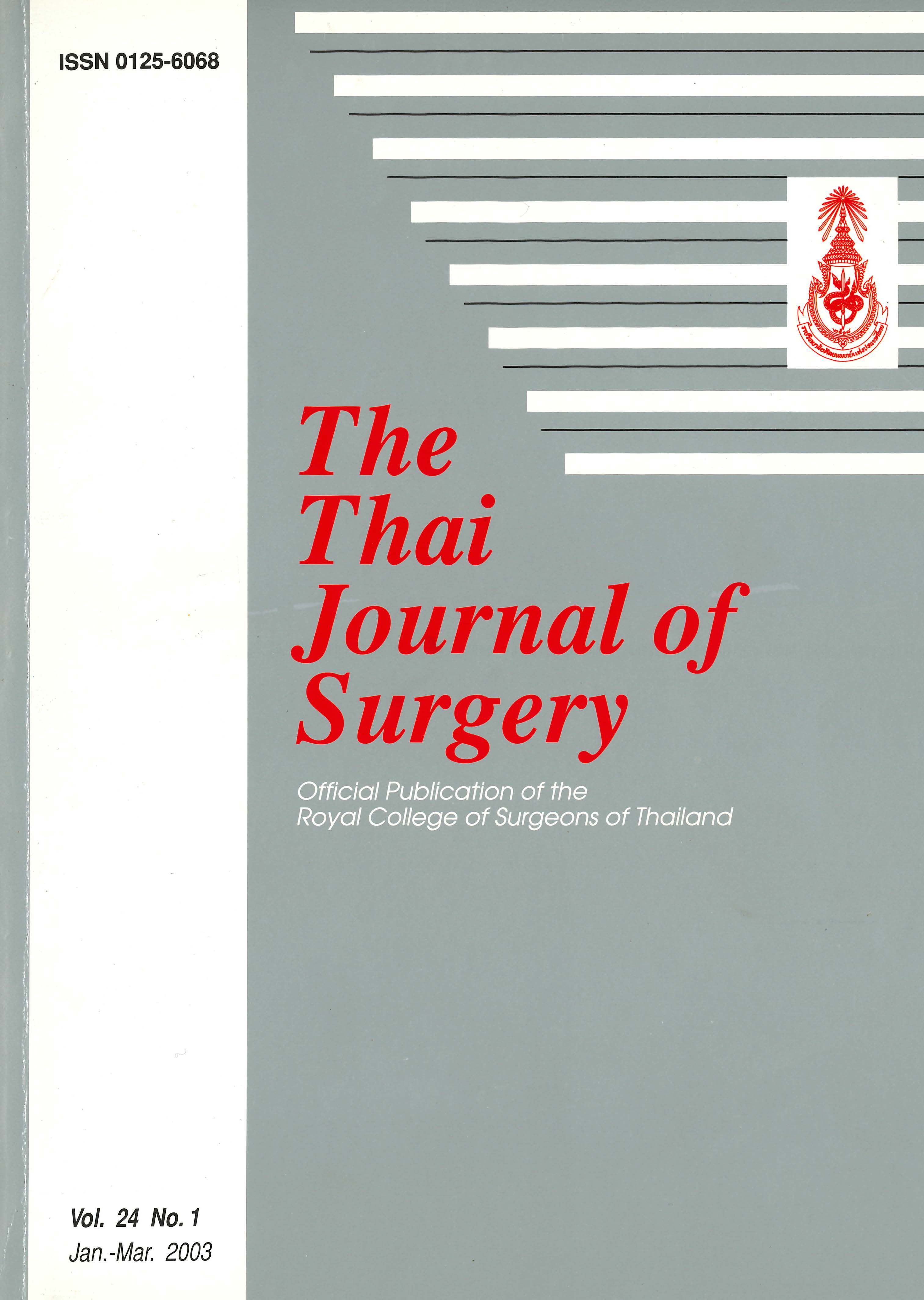Preoperative Serum Albumin Level and Postoperative Septic Complications
Abstract
Objective: To determine whether preoperative serum albumin level is significantly related to postoperative infectious and wound healing complications, after having adjusted for other risk factors.
Materials and Methods: Medical records of patients undergoing major abdominal operations, who were without predisposing conditions for infection or existing infections, and were not given total parenteral nutrition (TPN) were reviewed. Data from 140 patients in the period 1997 to 1998 were analyzed to study the association between risk factors (preoperative serum albumin, age, sex, ASA class, operative time, and body weight), and postoperative septic complications (wound dehiscence, wound infection, pneumonia, anastomotic leakage, sepsis, and intra-abdominal collection).
Results: Only low serum albumin level (less than 3.0 gm/dl) and ASA class were significantly related to postoperative septic complications (odds ratio: 8.21; 95% CI: 3.21 - 21.00 and odds ratio: 2.56; 95% CI: 1.35 - 4.88, respectively).
Conclusion: The results of this study suggest that preoperative serum albumin level in patients without certain comorbid diseases is associated with postoperative infectious and surgical complications. Low serum albumin level can be used as a marker for nutritional deficiency, and TPN as nutritional supplement in certain subset of patients may reduce postoperative septic complications. Among other risk factors examined, only the ASA class was also significantly related to postoperative septic complications.
References
2. Longo WE, Virgo KS, Johnson FE, et al. Risk factors for morbidity and mortality after colectomy for colon cancer. Dis Colon Rectum 2000; 43: 83-91.
3. Koperna T, Schulz F. Relaparotomy in peritonitis: prognosis and treatment of patients with persisting intraabdominal infection. Word J Surg 2000; 24: 32-7.
4. Onate-Ocana LF, Cortes-Cardenas SA, Aiello-Crocifoglio V, Mondragon-Sanchez R, Ruiz-Molin JM. Preoperative multivariate prediction of morbidity after gastrectomy for adenocarcinoma. Ann Surg Oncol 2000; 7: 281-8.
5. Yamaguchi K, Chijiiwa K, Yamashita H, Ogawa Y, Yoshida J, Tanaka M. Pancreatoduodenectomy for periampullary tumours: a univariate and multivariate analysis of the parameters influencing the morbidity, mortality and survival rates, Int Surg 1995; 80: 211-4.
6. Suzuki M, Otsuji M, Baba M, et al. Bronchopleural fistula after lung cancer surgery. Multivariate analysis of risk factors. J Cardiovasc Surg (Torino) 2002; 43: 263-7.
7. Patil PK, Patel SG, Mistry RG, et al. Cancer of the esophagus: esophago-gastric anastomotic leak-a retrospective study of predisposing factors. J Surg Oncol 1992; 49: 163-7.
8. Golub R, Golub RW, Cantu R, Stein HD. A multivariate analysis of factors contributing to leakage of intestinal anastomosis. J Am Coll Surg 1997; 184: 364-72.
9. Farinas-Alvarez C, Farinas MC, Fernandez-Mazarrasa C, Llorca J, Casanova D, Delgado-Rodriguez M. Analysis of risk factors for nosocomial sepsis in surgical patients. Br J Surg 2000;87:1076-81.
10. Gerhards MF, van Gulik TM, de Wit LT, Obertop H, Gouma DJ. Evaluation of morbidity and mortality after resection for hilar cholangiocarcinoma-a single center experience. Surgery 2000;127:395-404.
11. McCullagh P, Nelder NA. Generalized linear models 2nd ed. London: Chapman & Hall; 1989. p. 403.
12. Ulicny KS, Hiratzka LF, Williams RB, et al. Sternotomy infection: poor prediction by acute phase response and delayed hypersensitivity. Ann Thorac Surg 1990; 50: 949-58.
13. Schackert HK, Betzler M, Zimmermann GF, et al. The predictive role of delayed cutaneous hypersensitivity testing in postoperative complications. Surg Gynecol Obstet 1986;162:563-8.
14. Marin LA, Salido JA, Lopez A, Silva A. Preoperative nutritional evaluation as a prognostic tool for wound healing. Acta Orthop Scand 2002; 73: 2-5.
15. Carney DE, Meguid MM. Current concepts in nutritional assessment. Arch Surg 2002; 137: 42-5.
16. Nakamura K, Moriyama Y, Kariyazono H, et al. Influence of preoperative nutritional state on inflammatory response after surgery. Nutrition 1999; 15: 834-41.
17. Santoso JT, Canada T, Latson B, Aaaadi K, Lucci JA 3rd, Coleman RL. Prognostic nutritional index in relation to hospital stay in women with gynecologic cancer. Obstet Gynecol 2000; 95: 844-6.
18. Powanda MC. Plasma proteins and wound healing. Surg Gynecol Obstet 1981; 153: 749-55.
19. Rady MY, Ryan T, Starr NJ. Clinical characteristics of preoperative hypoalbuminemia predict outcome in cardiovascular surgery. JPEN 1997;21: 81-90.
Downloads
Published
How to Cite
Issue
Section
License
Articles must be contributed solely to The Thai Journal of Surgery and when published become the property of the Royal College of Surgeons of Thailand. The Royal College of Surgeons of Thailand reserves copyright on all published materials and such materials may not be reproduced in any form without the written permission.



